Join us as we explore the applications and trends of “augmented reality“ in the world of coffee.
BY VASILEIA FANARIOTI
SENIOR ONLINE CORRESPONDENT
Featured photo courtesy of Pixabay
In the ever-evolving landscape of technology, augmented reality (AR) has emerged as a transformative force, blurring the lines between the digital and physical worlds. As we step into 2024, statistics show that AR is poised to redefine the way we experience and interact with the world around us.
Today, we’re exploring the current state of AR technology, its emerging trends, and the potential impact it holds for the coffee industry.
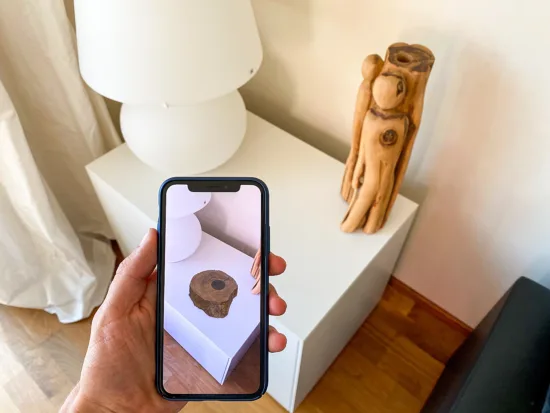 A glimpse into the transformative capabilities of augmented reality, which blurs the lines between the physical and digital realms. Photo via Unsplash.
A glimpse into the transformative capabilities of augmented reality, which blurs the lines between the physical and digital realms. Photo via Unsplash.Diverse Industries Embracing AR for Interactive Experiences
Augmented reality technology overlays digital information, such as images, videos, or 3D models, onto the real-world environment. Unlike virtual reality (VR), which immerses users in a completely virtual environment, AR enhances the physical world by adding digital elements.
AR is typically experienced through devices like smartphones, tablets, or AR glasses, offering users a blended experience where the virtual and real coexist seamlessly. This technology opens up seemingly endless possibilities for interactive and immersive experiences across diverse industries.
For example, Walmart, in collaboration with media giants like DC Comics and Marvel, introduced exclusive superhero-themed AR experiences in select stores, transforming static objects into dynamic, interactive displays. AR can also be used as an educational tool, as demonstrated by Toyota and Hyundai, both of which have used it to showcase complex car features. Cosmetic brands like L’Oréal and Sephora use AR to offer realistic previews of different makeup products on customers’ faces.
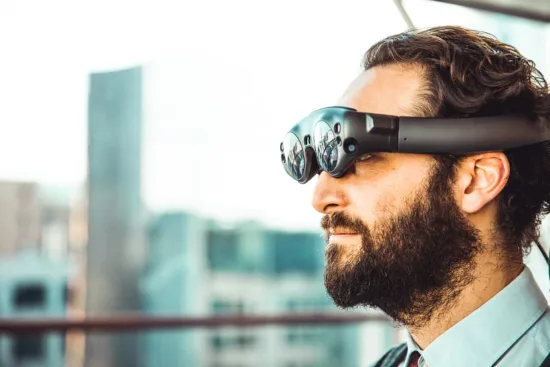 The immersive journey of AR extends beyond screens, paving the way for a future where technology seamlessly integrates into our surroundings through various tools such as goggles. Photo via Unsplash.
The immersive journey of AR extends beyond screens, paving the way for a future where technology seamlessly integrates into our surroundings through various tools such as goggles. Photo via Unsplash.Augmented Reality in the Coffee Industry
In the hospitality sector, AR is revolutionizing customer experiences. Virtual menus and interactive ordering systems are becoming commonplace, enhancing customer engagement and streamlining service. In the coffee industry, enhancing the customer experience is paramount. AR is paving the way for coffee enthusiasts to explore the origin of their favorite beans through interactive displays.
Imagine a coffee shop where customers can use AR apps to scan QR codes on coffee bags, revealing information about the beans’ origin, processing methods, and flavor profiles. This immersive experience adds a layer of storytelling to each cup, fostering a deeper connection between consumers and their coffee.
To offer an example, Victoria and Amy Kihnke, founders of Pure Origin Coffee, recently initiated an AR campaign aimed at sharing the compelling stories of their coffee growers. The innovative packaging they’ve introduced enables the incorporation of video testimonials directly from their farming partners.
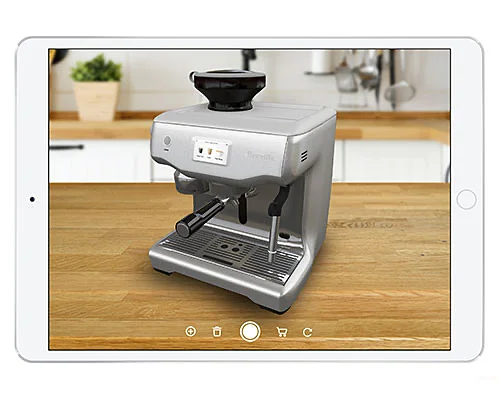 Breville redefines the coffee machine experience by integrating augmented reality into their product showcases. Photo courtesy of Breville.
Breville redefines the coffee machine experience by integrating augmented reality into their product showcases. Photo courtesy of Breville.Companies Brewing Success with AR
Several forward-thinking companies in the coffee industry have embraced augmented reality to elevate their offerings. Coffee machine manufacturers Breville, La Marzocco and Gaggia have harnessed AR technology to enhance the consumer experience, and have integrated it into their product showcases.
This allows potential buyers to virtually place coffee machines within their own kitchen spaces, offering a realistic preview of how these appliances would seamlessly fit into their daily lives. By leveraging AR in this manner, manufacturers facilitate an informed decision-making process for consumers, eliminating the need for guesswork and ensuring that the chosen coffee machine aligns perfectly with the customer’s preferences and kitchen aesthetic.
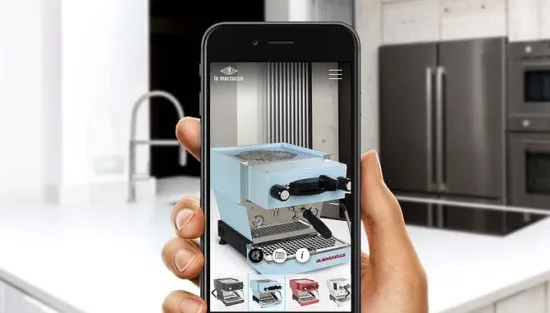 Prospective buyers can virtually place coffee machines in their kitchens, ensuring a perfect fit for their preferences. Photo courtesy of La Marzocco.
Prospective buyers can virtually place coffee machines in their kitchens, ensuring a perfect fit for their preferences. Photo courtesy of La Marzocco.Lavazza, on the other hand, is capitalizing on AR for customer care and maintenance. In 2021, the company joined forces with the video cloud platform SightCall to integrate augmented reality technology into its customer care and maintenance services for coffee machines. Leveraging SightCall’s AR interface, Lavazza’s dedicated customer service agents can remotely provide assistance by drawing, pointing, and highlighting directly on the customer’s device. This advanced approach proves particularly effective in addressing various support issues, including tasks like machine descaling.
The Shifting Landscape: Accessibility Driving AR Integration
While immersive technologies like AR have faced initial barriers to adoption, the imminent launch of Apple’s mixed reality glasses signifies a potential turning point. As these devices—capable of both virtual and augmented reality experiences—become more accessible, the integration of immersive technologies into our everyday lives is inevitable.
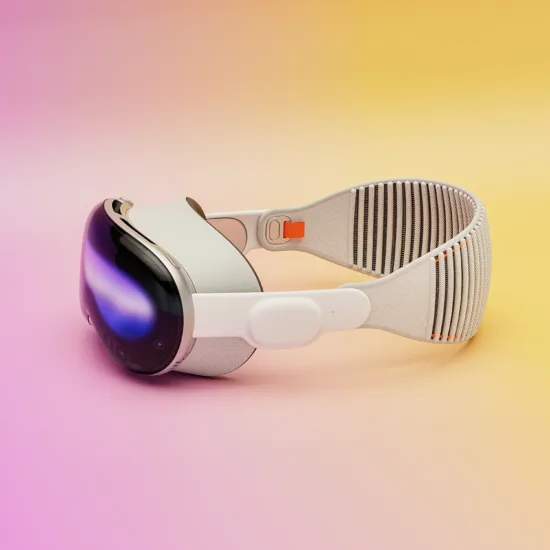 Vision Pro, Apple’s mixed reality glasses, are poised to be a game-changer for the integration of AR in everyday life. Photo via Unsplash.
Vision Pro, Apple’s mixed reality glasses, are poised to be a game-changer for the integration of AR in everyday life. Photo via Unsplash.The adoption of AR has faced initial barriers, especially in terms of cost. However, the upcoming accessibility of mixed reality devices signals a promising shift. Although currently AR technology is considered a substantial investment, its increasing availability is poised to lower barriers to adoption. This will allow more players in the coffee industry to harness its transformative capabilities.
The coffee industry, with its commitment to innovation, is well-positioned to embrace and leverage these technologies, ensuring that immersive experiences become an integral part of the daily coffee ritual, connecting us with our favorite brews in unprecedented ways.
ABOUT THE AUTHOR
Vasileia Fanarioti (she/her) is a senior online correspondent for Barista Magazine and a freelance copywriter and editor with a primary focus on the coffee niche. She has also been a volunteer copywriter for the I’M NOT A BARISTA NPO, providing content to help educate people about baristas and their work. You can follow her adventures at thewanderingbean.net.
Subscribe and More!

Out now: It’s the December 2023 + January 2024 issue! Read it for free with our digital edition. And for more than three years’ worth of issues, visit our digital edition archives here.
You can order a hard copy of the magazine through our online store here, or start a subscription for one year or two.
The post The Potential of Augmented Reality Technology for the Coffee Industry appeared first on Barista Magazine Online.
